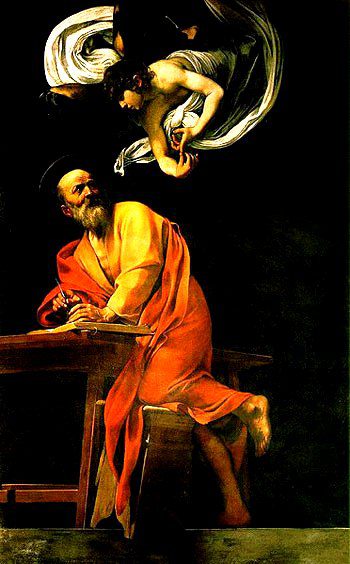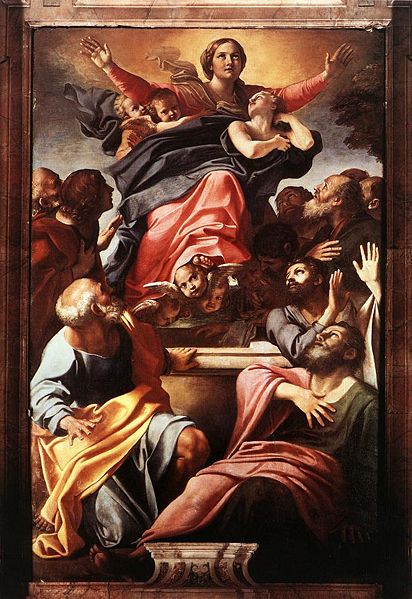Summer 2010. I arrived in Rome in the middle of a July heatwave. The parched air hung motionless at street level, smelling of ancient dust and modern pollution. After an hour of slithering through the sweaty bodies in Piazza Navona, I was desperate for a dark, cool refuge to hide from the relentless sun. I pulled the guidebook from my backpack and searched for an indoor attraction that might offer the needed relief.
A quick glance at the map showed me that the church of San Luigi dei Francesi was nearby and apparently worth a visit. Without reading further into the description, I set off in that direction.
From the outside, it didn’t look like much, especially in Rome where your criteria for aesthetics becomes skewed to the extreme. As I entered the church, I spotted a small group of Japanese tourists crowded around a side chapel just left of the main altar. A spotlight shut off with a loud clunk as they all re-capped their camera lenses and shuffled away from the darkened corner.
A moment later I walked up to the chapel by myself and drew a one Euro coin from my pocket. When I placed it into the slot, the spotlight came back on in a brilliant flash and I was overcome by what I saw: an angel, as real as the Japanese man who had just brushed my shoulder, dropping down from the sky and falling gracefully into this small space. Below him stood St. Matthew, looking as startled as I felt by the sudden appearance of this robed messenger.

This is classic Caravaggio, the full realization of the chiaroscuro style: employing dramatic use of light and dark to create a hyper-condensed moment in time. The whole scene floats over a black hole, where at any second it might be violently sucked in and just disappear forever. The periphery of the canvas is dark, but the two central characters are lit up as if a photograph had been snapped at the precise instant of a lightning strike.
After we catch our breath we realize that Matthew is a man, not a saint. His feet are bare and dirty, his face tired and wrinkled, the veins popping out on his hands. For better or worse, Caravaggio championed this Baroque philosophy, showing real life in extreme contrasts. But…life as it truly was and not how we wished it to be.
This put him at odds with many art critics and church officials of his time who preferred biblical scenes of majestic splendor and pastoral perfection—a style which had achieved its height during the Renaissance. Indeed, during this Baroque era of Italian painting in Rome, the two opposing camps were represented by Caravaggio on one side and his rival Annibale Carracci on the other.
First Stop: Piazza del Popolo
To fully appreciate this contrast in styles, go to the church of Santa Maria del Popolo where you can view these two very different artists side by side. You can plainly see Michelangelo’s influence in Carracci’s work, using soft pastel colors, and lots of fat cherubs clinging to Mother Mary. Also notice the order and symmetry. Now look to the left at Caravaggio’s “The Crucifixion of Saint Peter.” It’s difficult to believe that they were painted in the same year.
[one_half_first]

[/one_half_first][one_half_last]

[/one_half_last]
Once you’re finished admiring the paintings, step outside and take in the piazza itself; a masterpiece of Baroque expression in its own right. It is imposing, grotesque, enormous, overstated, and impressive. This was the goal of the Counter Reformation; to awe, inspire and even frighten all those who might be tempted to stray from the One True Faith. The message was, “Your life is small, pilgrim, but the lives of these angels and saints that inhabit our Holy City are grand. Take a knee. Humble yourself. You’re in the real house of God now.”
Imagine some peasant who had just traveled all the way from Spain or France on foot and arrived at the gates of Rome and the first thing they saw was this magnificent square. The feeble voice of Luther whispers, “God is everywhere…in the forest, in the provincial towns, in your heart.” But then you fix your gaze on Bernini’s piazza or Caravaggio’s painting and realize that only the true God could inspire talent so immense; only the true God has the capacity to communicate with such beauty and power. The words of Luther suddenly ring hollow and meaningless against this mighty spectacle: the city of Rome and all its miraculous treasures.
Welcome to the Counter-Reformation. Mission accomplished, now pass the collection plate. (These artists didn’t work for free, after all.)
Are you ready for more? Let’s go! You can follow with the map that I’ve created on Google Maps: Caravaggio in Rome
Second Stop: Sant’Agostino
Now we have arrived at The Church of Sant’Agostino. Here we can admire the famous “Madonna of Loreto.” The subject of Caravaggio’s painting could hardly be more simple and unassuming—once again he uses real people encountering the divine to breathe life into his art. In fact, the model for Mother Mary is said to be one of the many prostitutes with whom the artist was intimately familiar (don’t make me spell it out for you). If he was trying to provoke the moral watchdogs in Rome, once again he succeeded immensely.
We can again clearly distinguish a departure in styles if we have a look at Carraccci’s interpretation of this same scene (also in Rome, but not in this particular church—it’s at Chiesa di Sant’Onofrio al Gianicolo).
[one_half_first]

[/one_half_first][one_half_last]

[/one_half_last]
Indeed, Carracci portrayed the story of The Madonna of Loreto more literally, where we see the actual house of Mary’s youth being transported like some magic carpet from Nazareth in Galilee to a small village in Le Marche, Italy where it is said to have landed (intact, of course) after this mystical passage over oceans and continents.
Ahem—cough, cough. Well, I think we can leave that one alone for now and move on…
Third Stop: San Luigi dei Francesi; Caravaggio’s backyard
From here, we only have to walk a short way back to where we started this journey, at the Church of San Luigi dei Francesi. Besides the painting that I already mentioned (“The Inspiration of Matthew”) we can see the two others that complete the Matthew cycle, “The Calling of St. Matthew,” and “The Martyrdom of St. Matthew.” “The Calling” is particularly notable for its use of the light; notice how Christ is almost invisible in the shadows, but his “light” shines brightly on the astonished face of Matthew.
![]()
![]()
Once you’re done here, step outside, take a deep breath and let your eyes readjust. Studying Caravaggio’s paintings is a bit like looking at the sun: if you stare too long, your risk permanently altering your eyesight. He makes you believe that the illusions are real.
And by the way, the man himself lived right here in this neighborhood. In fact, in Palazzo Madama, practically across the street from where you’re standing right now. If you want to know more about him and see some of his other works in Rome, consult my map again. I’ve also listed the museums where many of his famous paintings are on permanent display.
I hope that you’ve enjoyed chasing Caravaggio in Rome with me. Of course, there are many masterpieces by history’s greatest artists scattered throughout this incredible city. But Caravaggio manages to stand out, even among this cast of all-star talent. In the words of one critic: “There was art before him and there was art after him—and they were not the same.”
CARAVAGGIO
In Sicily
Towards the end of his life, Caravaggio spent some time in Sicily; painting feverishly as he ran from his enemies. It was some of his best work.

did he use a camera ?
Rick — I’m out of breath chasing Caravaggio. Superb post!
Thanks so much, Tom! Cheers!
Interesting article ,, I differently should see Caravaggio’s masterpiece one day when I visit Rome:) thanks
Yes, Arwa, and so many of them can be seen for free, right in the very spot where he first placed them!
Bravo Riccardo, I really enjoyed the tour. My favorite is the Madonna di Loreto – Caravaggio version of course. Can you give it at the FAU Italian Art Showcase with Club Insieme on April, Friday 5th in PA101 at 7:00 pm?
Grazie, professoressa! Sure, I’d be happy to participate!
Thanks for this information! It’s about 38 years ago since I went hunting for Caravaggio in Rome. I think it’s time to pay another visit 🙂
Yes, he’s there waiting for you! 😉
E’ sempre bello leggere di Caravaggio e di Roma…hai dato un taglio personale e interessante alla descrizione delle opere, grazie!
Grazie a te aver letto!
I enjoyed the article very much. Do you know anything about Caravaggio’s in other towns in Italy?
Ciao Jason! Some of Caravaggio’s so-called “gallery pieces,” smaller works commissioned by private collectors for their homes, can now be found in museums around the world. However his best works are found in situ, in Italian churches. Outside of Rome, perhaps one of my favorites is “Sette opere di Misericordia,” in Naples. And he was also prolific in Sicily towards the end of his life–there is one of his paintings in Syracuse, two in Messina, and there WAS one in Palermo…but it was stolen by the mafia in 1969!
You are right, I am now considering using him as an example of achieving virtual reality in 2D.
It is often the case that conservative, traditional interpretations compensate for their lack of vision by increasing the technical expertise. The Venetian Tiepolo would be another example: his compositions seem photo realistic, and his ceiling illusions 3D but his subjects are traditional and conservative.
The baroque artists did two things. First, they brought the counter reformation into the artistic world, ending the almost postmodern trend of Georgione and Tintorretto. Artistic themes begun in the Renaissance would be dropped, and not picked up again till the late 19th century in Paris. Themes would be limited to classical and religious subjects. The second thing they did was to perfect the Venetian oil painting techniques begun by the Bellinis and Titian, and to make chiaroscuro into a 3D technique, bringing the Florentian ideas of perspective fully into oil painting.
Caravaggio in my mind carries on Georgiones shock and awe in the characterization of people, placing the viewer in a unique and uncomfortable position in relation to the subject. While Georgione’s subjects are more interesting, his characters were shocking because of what they were doing and what they appeared to be thinking. Caravaggio was the expert at placing the character in front of the viewer, so he took Georgione’s idea of the character encounter a step further. He replicates sculpture with 3D chiaroscuro, So he contributes to the final stages of the renaissance while at the same time maintains the subject censorship of the counter reformation.
Thank you for expanding on the details of the movement, professor, and you made an important distinction between artistic style and thematic objectives–they don’t always follow the same path hand-in-hand. I often get caught in the trap of assuming that art evolved lineally, but of course there was a lot jumping around and exchange of techniques and ideas. I like what you said about Caravaggio replicating sculpture with 3D chiaroscuro: he invites (compels) the viewer to fully step into the scene rather than just view it from a safe distance, which is what I think makes his work so appealing to the 21st century viewer. It’s virtual reality from the 1600’s. And he was quite a character, too, of course.